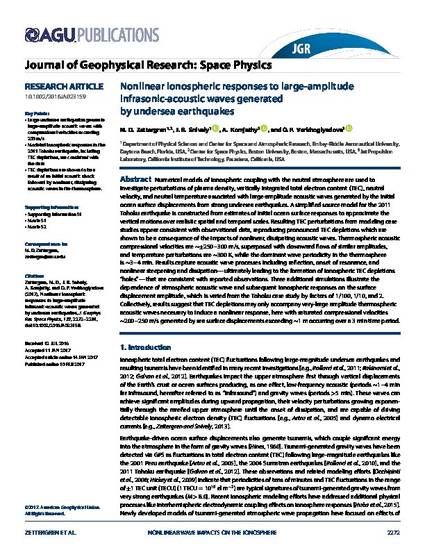
Numerical models of ionospheric coupling with the neutral atmosphere are used to investigate perturbations of plasma density, vertically integrated total electron content (TEC), neutral velocity, and neutral temperature associated with large-amplitude acoustic waves generated by the initial ocean surface displacements from strong undersea earthquakes. A simplified source model for the 2011 Tohoku earthquake is constructed from estimates of initial ocean surface responses to approximate the vertical motions over realistic spatial and temporal scales. Resulting TEC perturbations from modeling case studies appear consistent with observational data, reproducing pronounced TEC depletions which are shown to be a consequence of the impacts of nonlinear, dissipating acoustic waves. Thermospheric acoustic compressional velocities are ∼±250–300 m/s, superposed with downward flows of similar amplitudes, and temperature perturbations are ∼300 K, while the dominant wave periodicity in the thermosphere is ∼3–4 min. Results capture acoustic wave processes including reflection, onset of resonance, and nonlinear steepening and dissipation—ultimately leading to the formation of ionospheric TEC depletions “holes”—that are consistent with reported observations. Three additional simulations illustrate the dependence of atmospheric acoustic wave and subsequent ionospheric responses on the surface displacement amplitude, which is varied from the Tohoku case study by factors of 1/100, 1/10, and 2. Collectively, results suggest that TEC depletions may only accompany very-large amplitude thermospheric acoustic waves necessary to induce a nonlinear response, here with saturated compressional velocities∼200–250 m/s generated by sea surface displacements exceeding ∼ 1 m occurring over a 3 min time period.
